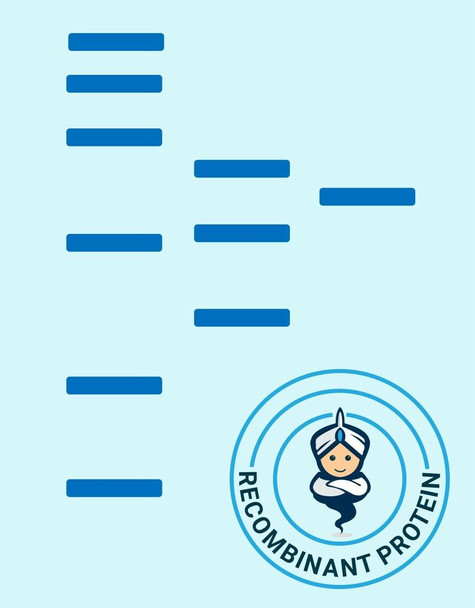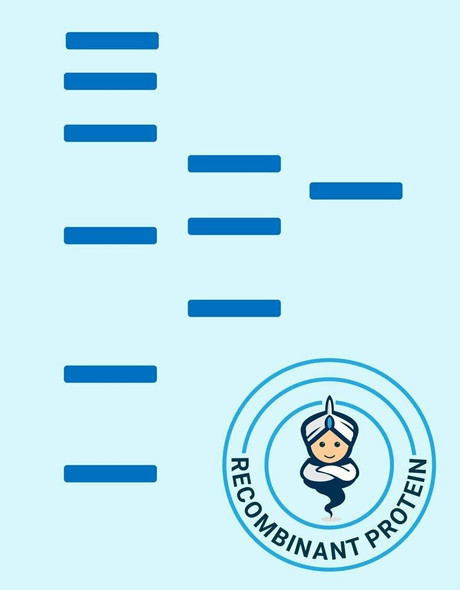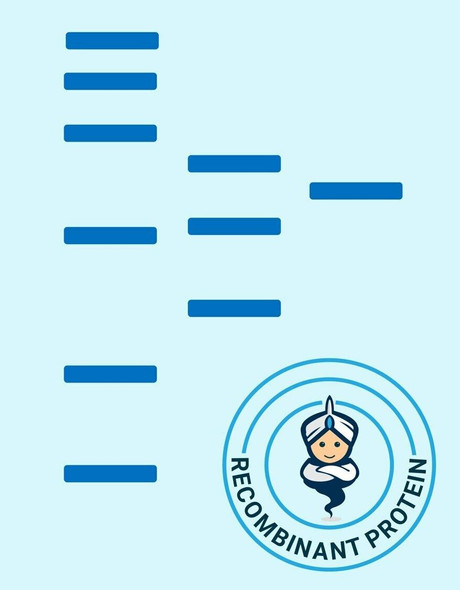Human EDAR Recombinant Protein (RPPB3389)
- SKU:
- RPPB3389
- Product type:
- Recombinant Protein
- Size:
- 10ug
- Species:
- Human
- Target:
- EDAR
- Synonyms:
- Ectodysplasin A Receptor
- Ectodysplasin 1
- Anhidrotic Receptor
- Anhidrotic Ectodysplasin Receptor 1
- Source:
- Sf9 Insect cells
- Uniprot:
- Q9UNE0
Description
| Product Name: | Human EDAR Recombinant Protein |
| Product Code: | RPPB3389 |
| Size: | 10µg |
| Species: | Human |
| Target: | EDAR |
| Synonyms: | Ectodysplasin A Receptor, Ectodysplasin 1, Anhidrotic Receptor, Anhidrotic Ectodysplasin Receptor 1, Ectodermal Dysplasia Receptor, Downless Homolog, EDA-A1 Receptor, DL, Tumor Necrosis Factor Receptor Superfamily Member EDAR, Downless, Mouse, Homolog Of, Ectodysplasin-A Receptor, ECTD10A, ECTD10B, EDA-A1R, EDA1R, ED1R, EDA3, HRM1, ED5, ED3. |
| Source: | Sf9 Insect cells |
| Physical Appearance: | Sterile filtered colorless solution. |
| Formulation: | EDAR protein solution (0.5mg/ml) contains 10% glycerol & Phosphate Buffered Saline (pH 7.4). |
| Stability: | Store at 4°C if entire vial will be used within 2-4 weeks. Store, frozen at -20°C for longer periods of time.For long term storage it is recommended to add a carrier protein (0.1% HSA or BSA).Please avoid freeze thaw cycles. |
| Purity: | Greater than 90.0% as determined by SDS-PAGE. |
| Amino Acid Sequence: | ADPEYSNCGE NEYYNQTTGL CQECPPCGPG EEPYLSCGYG TKDEDYGCVP CPAEKFSKGG YQICRRHKDC EGFFRATVLT PGDMENDAEC GPCLPGYYML ENRPRNIYGM VCYSCLLAPP NTKECVGATS GASANFPGTS GSSTLSPFQH AHKELSGQGH LATAAAAFES ACSLEPKSC DKTHTCPPCP APELLGGPSV FLFPPKPKDT LMISRTPEVT CVVVDVSHED PEVKFNWYVD GVEVHNAKTK PREEQYNSTY RVVSVLTVLH QDWLNGKEYK CKVSNKALPA PIEKTISKAK GQPREPQVYT LPPSRDELTK NQVSLTCLVK GFYPSDIAVE WESNGQPENN YKTTPPVLDS DGSFFLYSKL TVDKSRWQQG NVFSCSVMHE ALHNHYTQKS LSLSPGKHHH HHH |
Ectodysplasin A Receptor, also known as EDAR belongs to the tumor necrosis factor receptor family. EDAR is a receptor for the soluble ligand ectodysplasin A, and is capable of activating the nuclear factor-kappaB, JNK, as well as caspase-independent cell death pathways. EDAR is necessary for the development of hair, teeth, and other ectodermal derivatives. Furthermore, mutations in EDAR resulted in autosomal dominant and recessive forms of hypohidrotic ectodermal dysplasia.
EDAR produced in Sf9 Baculovirus cells is a single, glycosylated polypeptide chain containing 413 amino acids (27-187a.a.) and having a molecular mass of 45.6kDa. (Molecular size on SDS-PAGE will appear at approximately 40-57kDa).EDAR is expressed with a 249 amino acid hIgG-His-tag at C-Terminus and purified by proprietary chromatographic techniques.
| UniProt Protein Function: | EDAR: Receptor for EDA isoform A1, but not for EDA isoform A2. Mediates the activation of NF-kappa-B and JNK. May promote caspase-independent cell death. Defects in EDAR are a cause of ectodermal dysplasia anhidrotic (EDA); also known ectodermal dysplasia hypohidrotic autosomal recessive (HED). Ectodermal dysplasia defines a heterogeneous group of disorders due to abnormal development of two or more ectodermal structures. EDA is characterized by sparse hair (atrichosis or hypotrichosis), abnormal or missing teeth and the inability to sweat due to the absence of sweat glands. Defects in EDAR are the cause of ectodermal dysplasia type 3 (ED3); also known as ectodermal dysplasia hypohidrotic autosomal dominant or EDA3. ED3 is an autosomal dominant condition characterized by hypotrichosis, abnormal or missing teeth, and hypohidrosis due to the absence of sweat glands. |
| UniProt Protein Details: | Protein type:Receptor, misc.; Membrane protein, integral Chromosomal Location of Human Ortholog: 2q13 Cellular Component: apical part of cell; plasma membrane; integral to membrane Molecular Function:protein binding; transmembrane receptor activity; receptor activity Biological Process: epidermis development; pigmentation; hair follicle development; apoptosis; positive regulation of NF-kappaB import into nucleus; cell differentiation; signal transduction; odontogenesis of dentine-containing teeth Disease: Hair Morphology 1; Ectodermal Dysplasia 10a, Hypohidrotic/hair/nail Type, Autosomal Dominant; Ectodermal Dysplasia 10b, Hypohidrotic/hair/tooth Type, Autosomal Recessive |
| NCBI Summary: | This gene encodes a member of the tumor necrosis factor receptor family. The encoded transmembrane protein is a receptor for the soluble ligand ectodysplasin A, and can activate the nuclear factor-kappaB, JNK, and caspase-independent cell death pathways. It is required for the development of hair, teeth, and other ectodermal derivatives. Mutations in this gene result in autosomal dominant and recessive forms of hypohidrotic ectodermal dysplasia. [provided by RefSeq, Jul 2008] |
| UniProt Code: | Q9UNE0 |
| NCBI GenInfo Identifier: | 21263572 |
| NCBI Gene ID: | 10913 |
| NCBI Accession: | Q9UNE0.1 |
| UniProt Related Accession: | Q9UNE0 |
| Molecular Weight: | |
| NCBI Full Name: | Tumor necrosis factor receptor superfamily member EDAR |
| NCBI Synonym Full Names: | ectodysplasin A receptor |
| NCBI Official Symbol: | EDAR |
| NCBI Official Synonym Symbols: | DL; ED3; ED5; ED1R; EDA3; HRM1; EDA1R; ECTD10A; ECTD10B; EDA-A1R |
| NCBI Protein Information: | tumor necrosis factor receptor superfamily member EDAR |
| UniProt Protein Name: | Tumor necrosis factor receptor superfamily member EDAR |
| UniProt Synonym Protein Names: | Anhidrotic ectodysplasin receptor 1; Downless homolog; EDA-A1 receptor; Ectodermal dysplasia receptor; Ectodysplasin-A receptor |
| Protein Family: | Tumor necrosis factor receptor superfamily |
| UniProt Gene Name: | EDAR |
| UniProt Entry Name: | EDAR_HUMAN |










